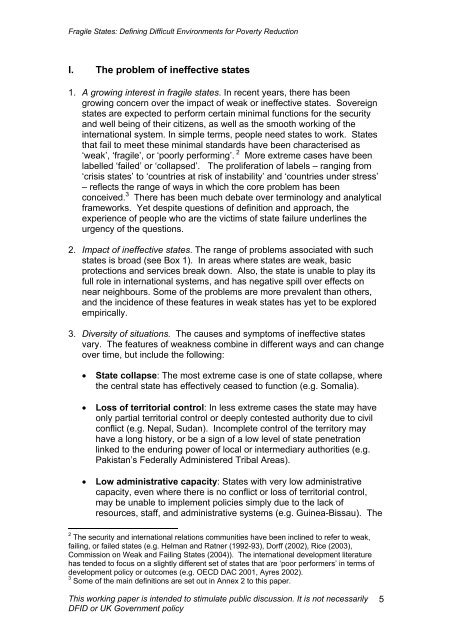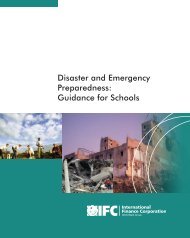Fragile States: Defining Difficult Environments for Poverty ... - INEE
Fragile States: Defining Difficult Environments for Poverty ... - INEE
Fragile States: Defining Difficult Environments for Poverty ... - INEE
Create successful ePaper yourself
Turn your PDF publications into a flip-book with our unique Google optimized e-Paper software.
<strong>Fragile</strong> <strong>States</strong>: <strong>Defining</strong> <strong>Difficult</strong> <strong>Environments</strong> <strong>for</strong> <strong>Poverty</strong> ReductionI. The problem of ineffective states1. A growing interest in fragile states. In recent years, there has beengrowing concern over the impact of weak or ineffective states. Sovereignstates are expected to per<strong>for</strong>m certain minimal functions <strong>for</strong> the securityand well being of their citizens, as well as the smooth working of theinternational system. In simple terms, people need states to work. <strong>States</strong>that fail to meet these minimal standards have been characterised as‘weak’, ‘fragile’, or ‘poorly per<strong>for</strong>ming’. 2 More extreme cases have beenlabelled ‘failed’ or ‘collapsed’. The proliferation of labels – ranging from‘crisis states’ to ‘countries at risk of instability’ and ‘countries under stress’– reflects the range of ways in which the core problem has beenconceived. 3 There has been much debate over terminology and analyticalframeworks. Yet despite questions of definition and approach, theexperience of people who are the victims of state failure underlines theurgency of the questions.2. Impact of ineffective states. The range of problems associated with suchstates is broad (see Box 1). In areas where states are weak, basicprotections and services break down. Also, the state is unable to play itsfull role in international systems, and has negative spill over effects onnear neighbours. Some of the problems are more prevalent than others,and the incidence of these features in weak states has yet to be exploredempirically.3. Diversity of situations. The causes and symptoms of ineffective statesvary. The features of weakness combine in different ways and can changeover time, but include the following:• State collapse: The most extreme case is one of state collapse, wherethe central state has effectively ceased to function (e.g. Somalia).• Loss of territorial control: In less extreme cases the state may haveonly partial territorial control or deeply contested authority due to civilconflict (e.g. Nepal, Sudan). Incomplete control of the territory mayhave a long history, or be a sign of a low level of state penetrationlinked to the enduring power of local or intermediary authorities (e.g.Pakistan’s Federally Administered Tribal Areas).• Low administrative capacity: <strong>States</strong> with very low administrativecapacity, even where there is no conflict or loss of territorial control,may be unable to implement policies simply due to the lack ofresources, staff, and administrative systems (e.g. Guinea-Bissau). The2 The security and international relations communities have been inclined to refer to weak,failing, or failed states (e.g. Helman and Ratner (1992-93), Dorff (2002), Rice (2003),Commission on Weak and Failing <strong>States</strong> (2004)). The international development literaturehas tended to focus on a slightly different set of states that are ‘poor per<strong>for</strong>mers’ in terms ofdevelopment policy or outcomes (e.g. OECD DAC 2001, Ayres 2002).3 Some of the main definitions are set out in Annex 2 to this paper.This working paper is intended to stimulate public discussion. It is not necessarilyDFID or UK Government policy5
















